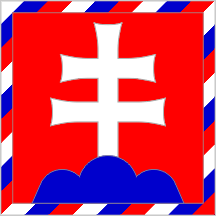![[Slovakian Coat of Arms]](../images/s/sk).gif) by Željko Heimer, 19 Jan 2003
by Željko Heimer, 19 Jan 2003

Last modified: 2006-02-11 by jarig bakker
Keywords: coa | lorraine cross |
Links: FOTW homepage |
search |
disclaimer and copyright |
write us |
mirrors
There is no doubt about the use of the arms with the Lorraine cross by Arpad and further dynasties ruling the Hungarian territories. But there is archaelogical evidence that this symbol was used in the area inhabited by Slav (later Slovak) population before the Hungarians conquered the Carpatian Basin. This old Christian symbol was brought to Great Moravia by the Byzantine priests Constantine (Cyrill) and Method. This doesn't refute the theory that the pope donated the cross to king Stephen but shows that Slovaks have certain rights to consider this cross as theirs. In Hungarian history this cross is first noticed on the shield of king Bela III. in 1189 and it is a frequent symbol in Slovak municipal heraldry. Ludovit Stur (1815 - 1856) took the Hungarian royal coat af arms and used it with an appropriate change of colours as a Slovak national symbol. The main fact why Slovaks used Hungarian coat of arms was that they simply felt a historical bond with the Hungarian state - the coat of arms belonged to them as well as to Hungarians or for example Serbians who lived within the boundaries of Hungarian kingdom. They only painted it with the colours they liked more because they represented the pan-Slav or Austro-Slav idea.
The present-day form of the Slovak state coat of arms was enacted on
1st March 1990 in the constitutional law of Slovak National Council and
was confirmed by the law from 18th February 1993. It's author is the painter
Ladislav Cisarik, jr. The official interpretation is that the Lorraine
cross symbolizes three important saints - St. Benedict, St. Constantine
and St. Method. Three hills are taken from the arms of Hungarian kings,
where it was green and was interpreted as three mountains Tatra, Matra
and Fatra. Since 1920 this coat of arms was depicted on the small Czechoslovak
state coat of arm on the chest of Czech lion rampant to express respect
and importance of Slovakia in the newly formed multi-national state. In
1960 the Slovak coat of arms in the arms of the Czechoslovak Socialist
Republic was changed with an inappropriate, newly created emblem - golden
fire in front of the silhouette of Mt. Krivan.
Jan Kravčík, 6 June 2000
![[Socialist Slovakia CoA (1960-1990)]](../images/s/sk)1960.jpg) by Martin Markovic, 10 Apr 2003
by Martin Markovic, 10 Apr 2003
This is the CoA of the former Slovak Socialist Republic (SSR, in Slovak:
Slovenská
socialistická republika (SSR)) in 1960-1990. In the red field there
is the blue silhouette of the Mount Krivan (Tatras). The fire on the flag
is supposed to represent the campfires of the partisan (ie. Communist)
resistance to the Nazis.
Martin Markovic, 10 Apr 2003
 by Željko Heimer, 19 Jan 2003
by Željko Heimer, 19 Jan 2003
President of the Republic. 1:1
Banner of the arms bordered bendy sinister white-blue-red. The banner
of the arms in square form, the elements are apparently
fimbriated in silver tread. The border is formed of diagonal stripes,
so that 9 fields are formed along each edge. The legislation on this flag
is available on Zákon
o štandarde prezidenta Slovenskej republiky, 19. januára 1993, Zbierka
zákonov RS 51/1993.
Željko Heimer, 19 Jan 2003
Last week (21 January 2006), I have seen this flag hoisted over the
seat of the Presidency in Bratislava, that is the former Garden Palace
of Count Grassalkovich.
The FOTW website mentions a law text prescribing this text. I suppose
there are provisions for the flag hoisting and I imagine that the flag
is hoisted over the palace when the President is actually there.
Ivan Sache, 29 Jan 2006